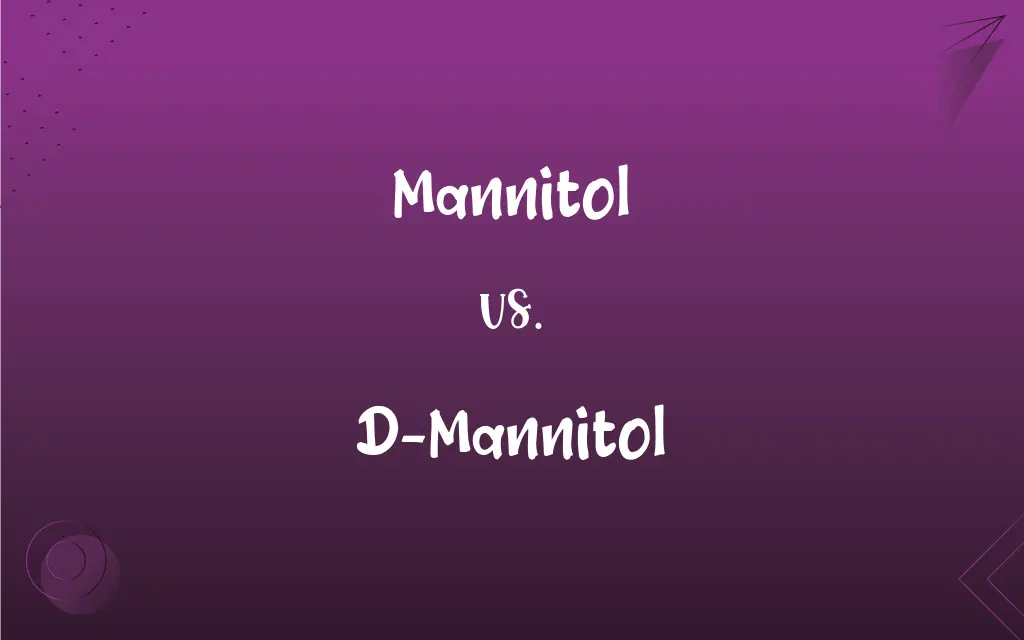Mannitol vs. D-Mannitol: What's the Difference?
Edited by Aimie Carlson || By Janet White || Published on December 14, 2023
Mannitol is a type of sugar alcohol used as a sweetener and medication, whereas D-Mannitol specifically refers to its D-isomeric form, a subtype with a particular molecular orientation.

Key Differences
Mannitol, a versatile sugar alcohol, serves various industrial and pharmaceutical purposes. D-Mannitol, its specific isomer, is characterized by its unique spatial arrangement, particularly in its molecular structure, which distinguishes it from other mannitol forms.
In medical applications, mannitol is widely recognized for its diuretic and renal protective qualities. The specific use of D-Mannitol capitalizes on its stereochemical properties, influencing its interaction with biological systems differently than other mannitol forms.
Mannitol is also utilized as a low-calorie sweetener in food products. In contrast, D-Mannitol's specific structure plays a critical role in certain specialized food applications, where precise molecular orientation is crucial.
In the realm of chemistry, mannitol is known for its chiral nature and ability to exist in multiple forms. D-Mannitol, in particular, exhibits properties that are essential in stereospecific chemical reactions, underscoring its importance in synthetic chemistry.
Mannitol broadly refers to a sugar alcohol with diverse uses, while D-Mannitol points to a specific stereoisomer of mannitol, which has distinct properties and applications due to its unique molecular orientation.
ADVERTISEMENT
Comparison Chart
Definition
A type of sugar alcohol
The D-isomeric form of mannitol
Molecular Structure
General structure of mannitol
Specific molecular orientation in D-isomer
Usage
Broad in food, medicine, and industry
Specific uses due to stereochemical properties
Importance in Chemistry
Known for chiral nature
Key in stereospecific reactions
Role in Medicine
Diuretic and renal protective
Particular interaction with biological systems
ADVERTISEMENT
Mannitol and D-Mannitol Definitions
Mannitol
A sugar alcohol used as a diuretic and sweetener.
Mannitol is often used in sugar-free candies.
D-Mannitol
Utilized in specialized food products.
D-Mannitol's structure is ideal for this dietary food.
Mannitol
A medication to reduce intracranial pressure.
Mannitol was administered to treat his head injury.
D-Mannitol
A variant of mannitol in chemical research.
D-Mannitol's properties are under study for new applications.
Mannitol
Employed in chewable tablets as a bulking agent.
Mannitol is included to increase the tablet's volume.
D-Mannitol
A specific isomer in pharmaceutical formulations.
D-Mannitol's form is effective in this drug's composition.
Mannitol
A renal protective agent in medical treatments.
Mannitol helps prevent kidney damage during surgery.
D-Mannitol
The D-form of mannitol, used in specific medical scenarios.
D-Mannitol was chosen for its precise molecular action.
Mannitol
Used in food processing as a thickener.
Mannitol thickens this low-calorie dessert.
D-Mannitol
Employed in stereochemistry for its unique orientation.
D-Mannitol is crucial in this stereospecific synthesis.
Mannitol
A white, crystalline, water-soluble, slightly sweet alcohol, C6H8(OH)6, found in plants, algae, and fungi. It is used in medicine, especially for its diuretic properties, and in foods as a sweetener and texturizer.
Mannitol
(organic compound) A polyhydroxy alcohol, an isomer of sorbitol, used as an artificial sweetener.
Mannitol
A white crystalline hexose (HO.CH2.(CHOH)4.CH2.OH) of a sweet taste obtained from a so-called manna, the dried sap of the flowering ash (Fraxinus ornus); - called also mannite, and hydroxy hexane. Cf. Dulcite. It is used in pharmacy as excipient and diluent for solids and liquids. It is also used as a food additive for anti-caking properties, or as a sweetener, and, illegally, to "cut" (dilute) illegal drugs such as cocaine or heroin.
Mannitol
A diuretic (trade name Osmitrol) used to promote the excretion of urine
FAQs
Are mannitol and D-mannitol chemically different?
Yes, they differ in molecular orientation; D-mannitol is a specific isomer.
What is mannitol's primary medical use?
It's used as a diuretic and to reduce intracranial pressure.
Is D-mannitol more expensive than mannitol?
Generally, yes, due to its specific production process.
What is mannitol?
Mannitol is a sugar alcohol used as a sweetener and medication.
Can both be used in food?
Yes, both are used in food, but D-mannitol in more specific applications.
Is mannitol safe for diabetics?
In moderation, as it doesn't significantly affect blood sugar levels.
Can mannitol cause side effects?
Yes, it can cause dehydration and electrolyte imbalance.
What distinguishes D-mannitol?
D-Mannitol specifically refers to the D-isomeric form of mannitol.
What is the role of D-mannitol in stereochemistry?
It's used for its specific molecular orientation in reactions.
Can mannitol be found in nature?
Yes, it occurs naturally in fruits and vegetables.
Can mannitol help in weight management?
As a low-calorie sweetener, it can aid in reducing calorie intake.
Is D-mannitol also used in medicine?
Yes, especially where specific stereochemical properties are needed.
How does mannitol function as a sweetener?
It provides a sweet taste without increasing blood sugar significantly.
Does D-mannitol have the same diabetic suitability?
Yes, but its usage is more controlled and specific.
How is mannitol administered medically?
It's given orally or intravenously, depending on the application.
Is D-mannitol also natural?
It is a synthetic variant of naturally occurring mannitol.
What's the difference in medical administration between them?
D-Mannitol is often used for more targeted medical applications.
Is mannitol used in renal treatments?
Yes, for its renal protective qualities.
Does D-mannitol share these renal benefits?
Yes, and often used where specific molecular action is required.
Is D-mannitol also used in weight management products?
Yes, particularly in specialized dietary products.
About Author
Written by
Janet WhiteJanet White has been an esteemed writer and blogger for Difference Wiki. Holding a Master's degree in Science and Medical Journalism from the prestigious Boston University, she has consistently demonstrated her expertise and passion for her field. When she's not immersed in her work, Janet relishes her time exercising, delving into a good book, and cherishing moments with friends and family.
Edited by
Aimie CarlsonAimie Carlson, holding a master's degree in English literature, is a fervent English language enthusiast. She lends her writing talents to Difference Wiki, a prominent website that specializes in comparisons, offering readers insightful analyses that both captivate and inform.







































































